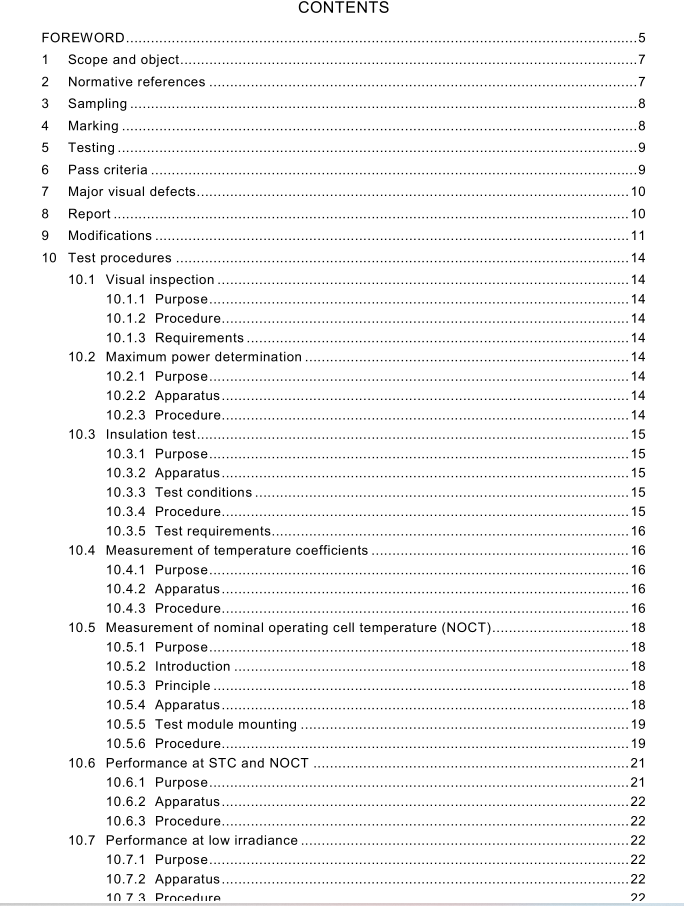IEC 61646 pdf – Thin-film terrestrial photovoltaic (PV) modules – Design qualification and type approval

IEC 61646 pdf – Thin-film terrestrial photovoltaic (PV) modules – Design qualification and type approval
1 Scope and object
This International Standard lays down requirements for the design qualification and typeapproval of terrestrial,thin-film photovoltaic modules suitable for long-term operation ingeneral open-air climates as defined in IEC 60721-2-1.This standard is intended to apply toall terrestrial flat plate module materials not covered by IEC 61215.
The test sequence is derived from lEC 61215 for the design qualification and type approval ofterrestrial crystalline silicon PV modules.However, it no longer relies on meeting a plus/minuscriterion before and after each test, but rather on meeting a specified percentage of the ratedminimum power after all of the tests have been completed and the modules have been light-soaked. This eliminates the technology-specific preconditioning necessary to accuratelymeasure the changes caused by the test.
This standard does not apply to modules used with concentrators.
The object of this test sequence is to determine the electrical and thermal characteristics ofthe module and to show, as far as possible within reasonable constraints of cost and time,that the module is capable of withstanding prolonged exposure in climates described in thescope.The actual life expectancy of modules so qualified will depend on their design,theirenvironment and the conditions under which they are operated.
2 Normative references
The following referenced documents are indispensable for the application of this document.For dated references,only the edition cited applies. For undated references, the latest editionof the referenced document (including any amendments) applies.
IEC 60068-1: Environmental testing -Part 1: General and guidance
IEC 60068-2-21: Environmental testing – Part 2-21: Tests – Test U: Robustness ofterminations and integral mounting devices
IEC 60068-2-78:2001,Environmental testing – Part 2-78: Tests – Test Cab: Damp heat,steady state
IEC 60410,Sampling plans and procedures for inspection by attributes
IEC 60721-2-1,Classification of environmental conditions – Part 2-1: Environmentalconditions appearing in nature – Temperature and humidity
IEC 60891,Procedures for temperature and irradiance corrections to measured l-vcharacteristics of crystalline silicon photovoltaic (PV) devices
IEC 60904-1:2006,Photovoltaic devices – Part 1: Measurements of photovoltaic current-voltage characteristics
IEC 60904-2,Photovoltaic devices – Part 2:Requirements for reference solar devices
IEC 60904-9,Photovoltaic devices – Part 9: Solar simulator performance requirementsIEC 60904-10,Photovoltaic devices – Part 10: Methods of linearity measurements
IEC 61215,Crystalline silicon terrestrial photovoltaic(Pv) modules – Design qualificationand type approval
ISO/IEC 17025,General requirements for the competence of testing and calibrationlaboratories.
3Sampling
Eight modules for qualification testing (plus spares as desired) shall be taken at random froma production batch or batches,in accordance with the procedure given in lEC 60410. Themodules shall have been manufactured from specified materials and components inaccordance with the relevant drawings and process sheets and shall have been subjected tothe manufacturer’s normal inspection, quality control and production acceptance procedures.The modules shall be complete in’every detail and shall be accompanied by themanufacturer’s handling,mounting and connection instructions,including the maximumpermissible system voltage.
lf the bypass diodes are not accessible in the standard modules, a special sample can beprepared for the bypass diode thermal test (see 10.18).The bypass diode should be mountedphysically as it would be in a standard module,with a thermal sensor placed on the diode asrequired in 10.18.2.This sample does not have to go through the other tests in the sequence.
When the modules to be tested are prototypes of a new design and not from production, thisfact shall be noted in the test report (see Clause 8).
4Marking
Each module shall carry the following clear and indelible markings:.name, monogram or symbol of manufacturer;
type or model number;
serial number;
polarity of terminals or leads (colour coding is permissible);maximum system voltage for which the module is suitable;
nominal and minimum values of maximum output power at STC, as specified by themanufacturer for the product type.
The minimum value of maximum output power refers to the lowest stabilized power that themanufacturer specifies for the product type (for example after any light induced degradationor recovery).
NOTE If the modules to be tested are prototypes of a new design and not from production, the results of this testsequence may be used to establish the module minimum power rating.









